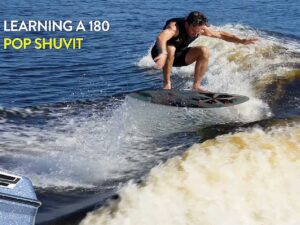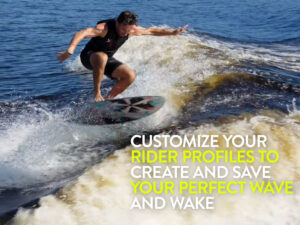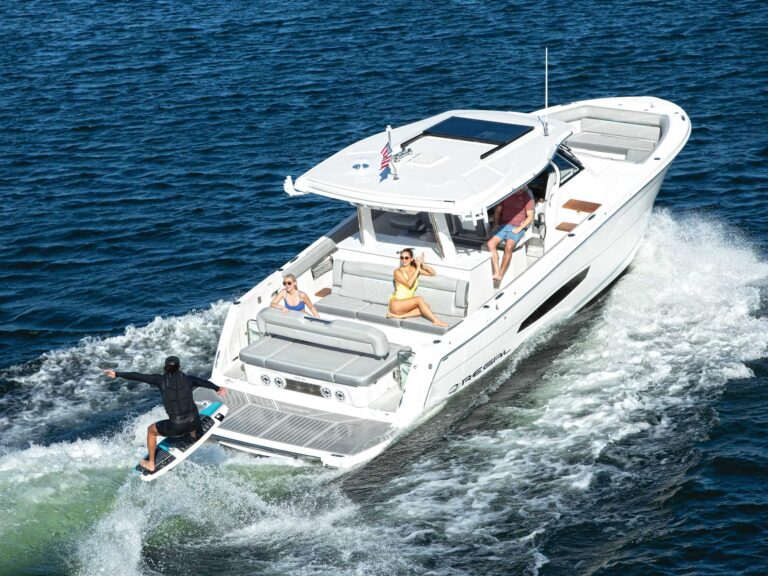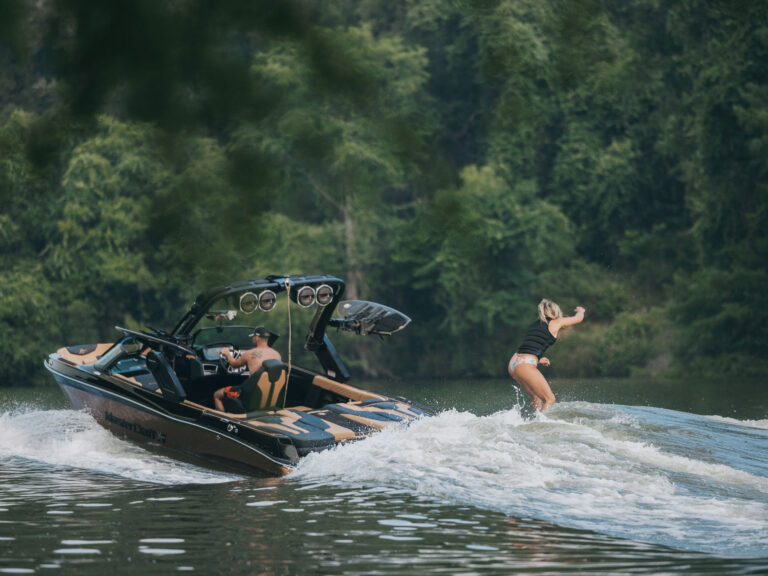Unfortunately, most people think that being able to do a flip makes you a good wakeboarder. They’re wrong. But the fact remains that inverted tricks are the moves that blow the non-wakeboarder’s mind.
“Everyone wants to learn a roll” says P.J. Marks of The Wakeboard Camp in Clermont, Florida. “It separates the men from the boys and the women from the girls.”
Before Marks will teach you a roll, he says there are certain basics of body positions and edging riders need to know before moving on to actual rolls. First, they have to be really comfortable getting good air. He says when you can consistently edge through the wake with your hips up without getting out of control, you are starting to be ready. When you can sky and land in flats every time without ever losing control, then you are getting closer to roll. But ultimately you have to be ready to commit.
“The problem is, a backside roll can’t be simulated on a tramp. You’ve got to just start trying it on the water,” Marks adds.
Backside Back Rolls
The first invert you should do is a backside back roll. Even though it looks like a flip, technically it’s just the natural result of a good hard cut and a slight move with your head. You don’t have to cut out very wide – probably 10 feet. According to Marks, most people think they have to generate a lot of speed to do a roll. You don’t. You want to go high and rotate slow rather than getting a lot of speed and rotating really fast. So start 10-15 feet outside the wake and turn super-slow so you have your hardest edge at the top of the wake.
Marks stresses to keep your hips up as you hit the wake. He claims that on almost every trick you should hit the wake basically the same – with your hips up, standing tall and on edge. This is especially important when learning your first rolls.
The key to the backside back roll is to let the wake throw you. Most people put way more work into this than they need to. They try throwing the board really hard over their heads, but that is wrong. It’s not a big power trick.
You should lead the rotation with your head. If you are left-foot-forward, look over your left side and push the board to that side (the left). Don’t push the board away from the boat because you’ll do more of a somersault, which, according to Marks, is bad form. Also, you don’t want slack in the rope. Do a progressive cut and keep the handle in by keeping your elbows close to your side. The ultimate goal is to rotate around the handle, and if the handle is in the center of your body, it makes the rotation all the easier.
The biggest mistake is cutting too hard too soon. The second is trying to throw the trick rather than just hitting the wake on edge. Lead with your head. It just takes a little twist of the shoulders and a turn of the
head, it’s not that big a difference.
If you want to go bigger, edge harder. Resist the force of the wake. Stand tall-think about bringing your hips up toward the handle. If you are hitting the back of the second wake, just shorten the rope.
If you follow these keys, you should be upside down by now and, in theory, spinning into the landing. Once you are rotating, you have to spot your landing. The only way to do this is if you keep your eyes open.
Backside Back Roll to Revert
and Half-Cab Roll
The half-cab roll is a switchstance backside back roll to revert. So both tricks use the same exact technique – one just happens to be switch. Before you head
off tryi your roll to revert you obviously must have your backside roll wired. Then get the hang of doing simple backside wake jumps to revert, letting go of the handle with your front hand at the peak of the jump, then concentrating on pushing your trailing hand to (or behind) your trailing hip so you land revert. Get really used to the feeling of landing a big jump switch.
When you are ready to throw the actual roll to revert, go through the normal roll procedure. Halfway through the roll, start to bring the handle towards what was your trailing hip. About three-fourths through the move, let go with your normal front hand and push the handle back behind your trailing hip,
Frontside Roll
Some people learn this as their first roll simply because it is easy to practice on the trampoline, diving board, etc. But most people really have a hard time with this trick because their frontside edging isn’t as strong as it needs to be. Before attempting this trick, make sure you can sky your frontside jumps as big, or almost as big, as your backside.
You need to carry an extremely strong edge into the wake. As P.J. points out, to get a true frontside edge you have your hips and toes pointing away from the boat. A lot of people can’t get enough angle to the wake on this cut. Try to get the board pointing toward the wake, not the boat as you cut. “Plus,” Marks stresses, “your hips should be straight to get the cut – bend at the knees. A lot of people initiate this trick bent over, but you should hit the wake straight and upright.” Most of the problems in this move actually come from the cut, so if you’ve got that down you shouldn’t be too far from the frontside back roll.
Dave Briscoe from Ski Away Ski School in Winter Haven, Florida, says there are two ways to do this move. If you can do a back flip on a tramp you should do the move with the same rotation as a tantrum.
So take a progressive cut on your toeside edge with dominant weight on your front foot. He stresses not to cut too early in the move. Just drift to the spray mark (about 7 feet outside the wake) and build your edge from there. That way you can have maximum edge at the top of the wake. On the top of the wake, go from your toes to your heels, throw your head straight back off the top of the wake as you would doing a flip on a tramp, and let go with your rear hand. As you spot your landing think about bringing your knees under you, not your board.
If you aren’t comfortable doing a flip on a trampoline or a tantrum, then at the top of the wake instead of switching your weight from toeside to heelside, throw your head away from the way the boat is going and turn your hips to where you are looking. For this style of frontside roll, Briscoe says it’s best to keep two hands on the handle; however, this tends to cause you to land revert. Another common problem here is having too much weight on back foot. If you leave the wake on your back foot, you land on your back foot, which makes it hard to hang on.
Frontside Roll-to-Revert
This move might even be easier than the standard frontside back roll because you have a natural inclination to land revert. If you’ve been
trying your frontside back roll and are landing sideways, you didn’t look away from the boat during the move. The good news is, that’s basically a frontside roll to revert. Pro rider Cobe Mikacich says if you want to go to revert, just hang on with two hands and concentrate on landing with your shoulders facing toward shore. “If you can land revert really hard it’s easy to land this move.”
So, keeping dominant weight on your front foot, leave the wake just like on the frontside roll. Once upside down, just push the handle to your back hip with both hands. This will turn you facing the boat.
Tantrum
The tantrum is another move you can learn on the trampoline. It’s just a back flip – feet going over your head. Cut out wide – the wider you go the more time you’ll have to do a slow, progressive cut, but take your time with this move. Most people try to go at it too fast. If you carry too much speed it’s hard to get the flip going over the top and you’ll come around the corner – almost like an S-bend. So get some momentum toward the wake, keeping most of your weight on your front foot. When you reach the wake, back off on the cut as if you were going to ride back down the wake
. Stand tall to get your head and chest up and lead the trick with your head. The momentum of standing tall and hitting the wake will stop your board and throw you over. Make sure you look straight back to keep the move untwisted. If you stay on your heelside edge, it makes the board go behind you instead of letting it do a true back flip.
Slowly release your hand off the handle as you come through the foam. Then just look for the water. To start with, going off the
double-up is easiest because you don’t have the edge change to worry about, but eventually you’ll get to the point where you do a Raley cut, back off and stand tall.
Front Flip
This is another move where there are two ways you can do it – like a cartwheel or like a somersault. Most pros like to do the cartwheel type (Mike Weddington, Cobe Mikacich, Andrea Gaytan) – it’s more technically correct and a little easier to learn. Guys like Darin Shapiro, Shannon Best and Jeremy Kovak tend to do the somersault; the board travels less end over end, but it’s a little easier to throw in a grab this way since you have to let go with your back hand.
Andrea Gaytan, who does a cartwheel-type front, says the main key is to put all your weight on your back foot and don’t start too far out. Load the line. When you throw it you want to aim your shoulders at the shore and keep your arms down
Cobe Mikacich takes those instructions a little further. He says to start with a progressive edge. Off the wake ride the board straight up so your nose is pointing at the shore, not away from the boat like when you are going to do a big roll. Edge off your back foot. The biggest thing to think of is making the board go end over end – your body has to do a cartwheel. Ride on the heel of your back foot; at the top of the wake, do not take the weight off your heel.
Briscoe cautions not to let your board go on a toeside edge because it will cause the board to go behind you – not end over and as it should. Cobe says to ride up the wake like you’re doing an ollie. As you approach the top of the wake, lock your back leg straight, that’s what gives you the kick.
If you are going to do a big front, keep your shoulders parallel to your handle and throw your front shoulder toward the tip of the board. This will send you into the cartwheel. In the air Cobe cautions to keep everything going toward shore-that will keep your line tight.
A lot of times it’s easy to overdo it. If you keep your line tight, your momentum will keep going with the boat. Otherwise, with slack line you will land really flat and hard and have a tough time riding away from this move. on the frontside roll. Once upside down, just push the handle to your back hip with both hands. This will turn you facing the boat.
Tantrum
The tantrum is another move you can learn on the trampoline. It’s just a back flip – feet going over your head. Cut out wide – the wider you go the more time you’ll have to do a slow, progressive cut, but take your time with this move. Most people try to go at it too fast. If you carry too much speed it’s hard to get the flip going over the top and you’ll come around the corner – almost like an S-bend. So get some momentum toward the wake, keeping most of your weight on your front foot. When you reach the wake, back off on the cut as if you were going to ride back down the wake. Stand tall to get your head and chest up and lead the trick with your head. The momentum of standing tall and hitting the wake will stop your board and throw you over. Make sure you look straight back to keep the move untwisted. If you stay on your heelside edge, it makes the board go behind you instead of letting it do a true back flip.
Slowly release your hand off the handle as you come through the foam. Then just look for the water. To start with, going off the
double-up is easiest because you don’t have the edge change to worry about, but eventually you’ll get to the point where you do a Raley cut, back off and stand tall.
Front Flip
This is another move where there are two ways you can do it – like a cartwheel or like a somersault. Most pros like to do the cartwheel type (Mike Weddington, Cobe Mikacich, Andrea Gaytan) – it’s more technically correct and a little easier to learn. Guys like Darin Shapiro, Shannon Best and Jeremy Kovak tend to do the somersault; the board travels less end over end, but it’s a little easier to throw in a grab this way since you have to let go with your back hand.
Andrea Gaytan, who does a cartwheel-type front, says the main key is to put all your weight on your back foot and don’t start too far out. Load the line. When you throw it you want to aim your shoulders at the shore and keep your arms down
Cobe Mikacich takes those instructions a little further. He says to start with a progressive edge. Off the wake ride the board straight up so your nose is pointing at the shore, not away from the boat like when you are going to do a big roll. Edge off your back foot. The biggest thing to think of is making the board go end over end – your body has to do a cartwheel. Ride on the heel of your back foot; at the top of the wake, do not take the weight off your heel.
Briscoe cautions not to let your board go on a toeside edge because it will cause the board to go behind you – not end over and as it should. Cobe says to ride up the wake like you’re doing an ollie. As you approach the top of the wake, lock your back leg straight, that’s what gives you the kick.
If you are going to do a big front, keep your shoulders parallel to your handle and throw your front shoulder toward the tip of the board. This will send you into the cartwheel. In the air Cobe cautions to keep everything going toward shore-that will keep your line tight.
A lot of times it’s easy to overdo it. If you keep your line tight, your momentum will keep going with the boat. Otherwise, with slack line you will land really flat and hard and have a tough time riding away from this move.







